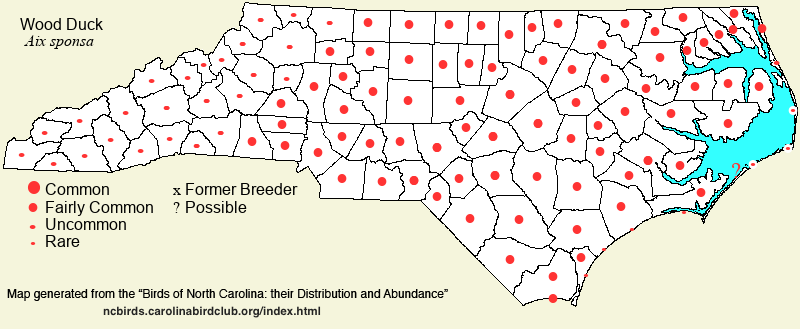 |  |
|
Wood Duck - Aix sponsa ANATIDAE Members: | Search Common: Search Scientific: |
|
|
|||||||
| General Comments | One of the world's most beautiful ducks, the Wood Duck occurs statewide in the breeding season, the only waterfowl with a native, "non-feral" population that breeds in all counties. Numbers seem to have been on the slow increase, owing to an increase in Wood Duck nest boxes erected for the birds and to an increase in beaver ponds, a primary habitat. The species nests in cavities in dead trees, nest boxes, and knotholes, at wooded or semi-wooded fresh water ponds, lakes, and larger streams. Wintering habitat is similar -- wooded or semi-wooded ponds, impoundments, swamps, and larger streams. At that season, there is a withdrawal of birds from the mountains and Piedmont, and it is rather scarce in winter outside of the Coastal Plain. | ||||||
| Breeding Status | Breeder | ||||||
| NC BRC List | Definitive | ||||||
| State Status | |||||||
| U.S. Status | |||||||
| State Rank | S5B,S4N | ||||||
| Global Rank | G5 | ||||||
| Coastal Plain | Fairly common to common summer resident, except mostly uncommon at that season along and very near the coast. Less common (or at least more local) in winter, being at least fairly common by midwinter, but can be common in a few swamps and wooded impoundments. Peak counts: 1,570, Orton Pond (Brunswick), 12 Jan 2022; 556 near Rocky Mount (Edgecombe), 17 Dec 2010. | ||||||
| Piedmont | Fairly common, though a bit local, summer resident. Mostly uncommon in winter, more frequent in the eastern portions than in the western (where it can be rare). Peak counts: | ||||||
| Mountains | Generally uncommon summer resident. Rare to uncommon in winter, mostly below 2,500 feet elevation. Very rare in winter over 3,000 feet elevation. Peak counts: | ||||||
| Finding Tips |
Though this is a reasonably common duck in the state, it can be a little bit difficult to find the species at publicly owned sites such as coastal refuges. Nonetheless, since the species occurs at thousands of lakes, ponds, creeks, and rivers in the state, specific sites are not needed. *** | ||||||
| Attribution | LeGrand[2023-03-01], LeGrand[2022-04-25], LeGrand[2011-12-31] | ||||||
| NC Map Map depicts all counties with a report (transient or resident) for the species. | Click on county for list of all known species. |
| NC Breeding Season Map Map depicts assumed breeding season abundance for the species. |  |